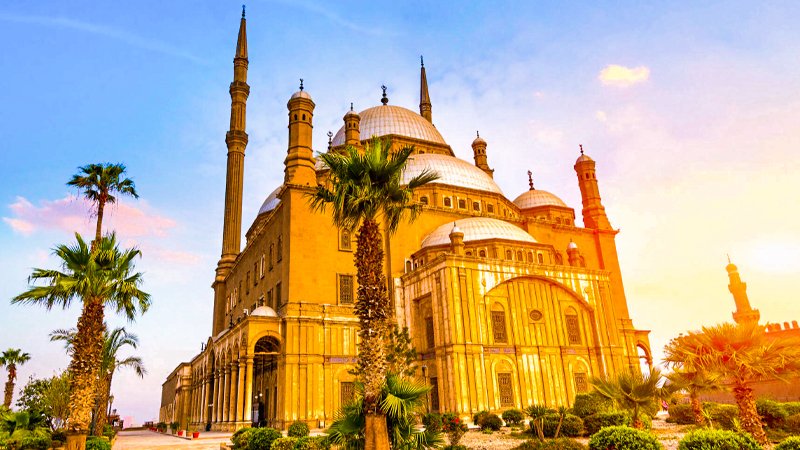Nestled within the Cairo Citadel, overlooking the bustling cityscape of Cairo, lies the impressive Mosque of Muhammad Ali. This architectural masterpiece, also known as the Alabaster Mosque due to its striking use of this material, stands as a symbol of Egypt’s rich Islamic heritage and offers visitors a profound glimpse into its history.
Historical Significance and Architecture
The Mosque of Muhammad Ali, commissioned by Muhammad Ali Pasha, the Ottoman governor of Egypt, in the early 19th century, represents a significant era in Egyptian history. Designed by the renowned architect Yusuf Bushnak, its construction began in 1830 and took over 18 years to complete. The mosque’s design mirrors the Ottoman style, blending traditional Turkish architecture with distinct Egyptian elements, making it a unique cultural hybrid in Cairo.
Architectural Features and Design
As visitors approach the mosque, they are immediately struck by its grandeur. The exterior, clad in striking alabaster stone, glistens under the Egyptian sun, exuding a sense of purity and grace. The expansive courtyard, surrounded by towering minarets and crowned by a large central dome, welcomes worshippers and tourists alike with its serene ambiance.
Inside, intricate details adorn the mosque’s interior walls and ceilings, showcasing exquisite craftsmanship and attention to detail. The central prayer hall, adorned with ornate chandeliers and richly woven carpets, invites quiet contemplation and reverence. Visitors can also marvel at the stunning stained glass windows that bathe the interior in a kaleidoscope of colors, adding to the mosque’s ethereal beauty.
Cultural and Religious Significance
Beyond its architectural splendor, the Mosque of Muhammad Ali holds deep cultural and religious significance for Egyptians. As a functioning mosque, it remains an active center of worship, drawing devout Muslims who come to pray and seek spiritual solace. Its role extends beyond religious practices, serving as a venue for community gatherings, religious ceremonies, and cultural events that celebrate Egypt’s Islamic traditions.
Visitor Experience and Practical Information
For travelers embarking on a journey to explore Cairo’s historical treasures, a visit to the Mosque of Muhammad Ali is a must. Located atop the Citadel, visitors can combine their exploration with panoramic views of Cairo’s skyline and the nearby landmarks, such as the Sultan Hassan Mosque and the ancient ruins of Memphis.
When planning a visit, it’s advisable to check local customs and dress modestly out of respect for the mosque’s sacred atmosphere. Guided tours are available to provide insights into the mosque’s history and architectural significance, enhancing the visitor experience with expert knowledge and anecdotes.
Conclusion
In conclusion, the Mosque of Muhammad Ali stands as a testament to Egypt’s enduring cultural heritage and architectural prowess. Its blend of Ottoman and Egyptian styles, coupled with its historical significance, makes it a captivating destination for travelers seeking to immerse themselves in Egypt’s rich Islamic history. Whether marveling at its majestic domes and minarets or reflecting in its tranquil interiors, visitors are sure to be inspired by the beauty and spirituality that define this iconic landmark.
By experiencing the Mosque of Muhammad Ali firsthand, travelers not only enrich their understanding of Egypt’s past but also forge a deeper connection to its vibrant present. As you plan your journey to Egypt, let the Mosque of Muhammad Ali be a highlight of your itinerary, promising an unforgettable encounter with history, culture, and architectural splendor.

